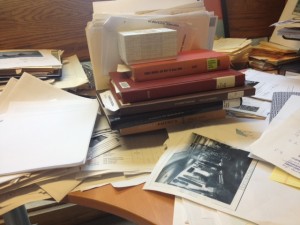Developing your synthetic powers
13 March 2015 – Suzanne Fischer
Doing public history, in all its diverse manifestations, requires certain specialized habits of mind. One of the most vital but also the most mysterious is synthesis.
When I begin work on an exhibition, such as the one I’ve been developing for the past two years, I read as many books and talk to as many people as I can, and then–I wait. I wait to wake up at 5 am with an exhibit concept plan fully formed in my head. I wait to discover an important idea by talking it out with a friend over coffee. I wait to be suddenly struck in the middle of a meeting with the solution to a convoluted conceptual problem that I immediately scribble down as if I’m taking notes on whatever the meeting is actually about. I wait–and I trust the process because I know it works and because I have developed and exercised my synthetic powers before and I know that they require patience. In comes 100 scholarly monographs, out comes 30 accessible fifty-word labels, without fail.
Though it can feel magical, especially once you’ve internalized the work it takes, synthesis is a creative skill that public historians can learn and teach.
To cultivate your synthetic powers, first of all read widely and reach out widely. You need to absorb a large body of work, a large quantity of ideas and opinions, to practice synthesis. It helps to start with the most up-to-date scholarship, which should have the best bibliographies to mine. Talk to community members about what writing, ideas, and art have made an impact for them in this area. Read monographs, novels, poems, and blog posts. Look at as many artifacts as you can. The sources you compile don’t need to be read exhaustively. Absorption is the keyword. Don’t sweat it too much but read for argument and citation, so you start to map the field in your mind–what ideas and what people are important to understanding the topic
In your source-gathering, seek patterns. Humans tend to do this instinctively but turning it into an intentional search will heighten the effects. These are the kinds of patterns to look for in your research materials and when talking to experts, informants, and community members: consensus (where do all of your sources agree?), controversy (where do they disagree?), disputed facts, and especially quotations (lots of your sources may use one or two of the same poignant quotations). Use your literature-reading skills and pay attention to narrative. How do different sources tell the “same” story? Who do they emphasize, what events? Different patterns of emphasis can be revealing. Be sure to keep track of these points of consensus and controversy and the possible interpretive approaches.
Here’s where the public history synthetic process differs from that of other kinds of research. You must know your constraints and know what you need. A museum exhibit is different from a documentary film, and a 300-square foot museum exhibit is different from a 3,000-sq ft museum exhibit. This is pretty obvious, but it means that you need to have a sense of how many of the things you’ve learned will fit in the project and where. There will never be enough space for everything you’ve learned, so you need to train yourself to start from very broad categories rather than from specific small details. An important caveat: an artifact can be a small detail, and artifacts may be the heart of your project. This means that you need to constantly test your high-level ideas iteratively against the artifacts.
When you try to synthesize a lot of material into an exhibit plan or some other document or concept, it’s hard to get the scale right–either you go too far and lose the fascinating particularities that attracted you to the topic in the first place or you don’t go far enough and end up with a list of facts. Both are deadly and will bore you and your colleagues. If you’re not excited about the project, your visitors won’t be either. Latch onto what interests you. Trust your gut, guided by your intensive absorption of all the research material and by conversations with colleagues and community members. If you can’t stop thinking about a story you heard, it probably belongs in the project.
The last step in synthetic thinking is the hardest to fit in a public historian’s schedule: take time. If you don’t have time to think, your project is going nowhere. Build time for synthesis into your schedules and budgets–we usually just call it “research.” Thinking is work. Thinking is the work of public historians.
~ Suzanne Fischer is associate curator of contemporary history and trends at the Oakland Museum of California.





A great post – for those that are managing curatorial departments, I think one of the most valuable roles managers can play on exhibit projects is to be “space makers.” Senior management can often be anxious about new exhibit projects and want to see outlines, curatorial statements, and text in an early phase – as a manager, I always saw my role was to take the brunt of that angst so that curators could just think and let the process happen – and it worked, every time.
Excellent! Managing a project and creating project require different skills. Based upon my own experiences, there are people who just naturally work this way when developing. I know that I do. Ideas come easily; putting them together into a cohesive project that explores and grasps patterns and people’s lives takes time and research. Nice to see the process written down.
This sounds like excellent advice. I should to take it to heart when planning how to do a better job of presenting the “artifacts” I come across on my historical bicycle rides.